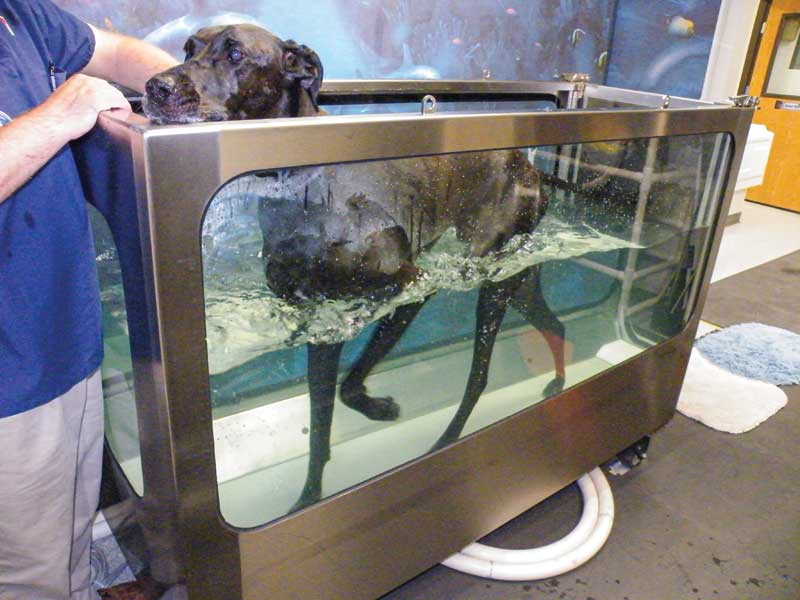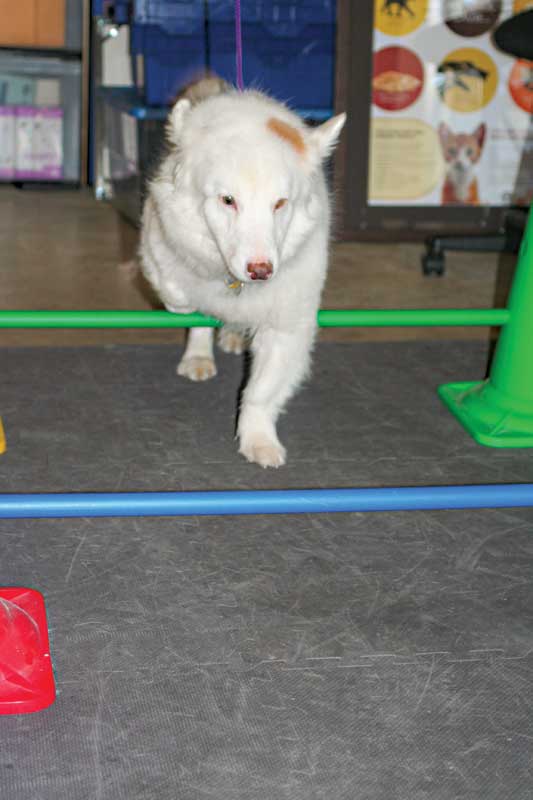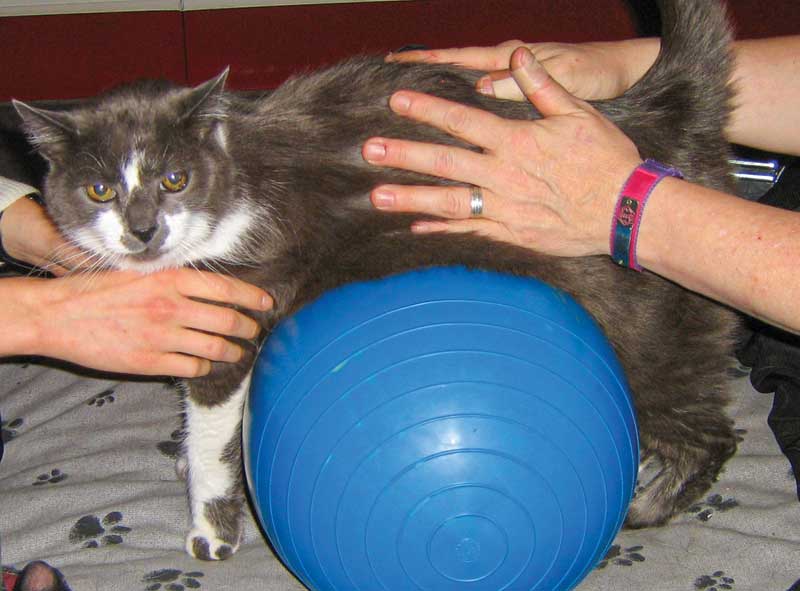
Physical rehabilitation is an exceptionally useful discipline and set of techniques to help pets—both cats and dogs—regain function and strength following an injury or surgical intervention, or to restore/sustain strength and function in the face of chronic changes from osteoarthritis.
As helpful as physical rehabilitation is, it is critical to relieve and control a pet’s pain before embarking on rehabilitation techniques, such as tissue manipulation, joint mobilization, therapeutic exercise, or hydrotherapy (working out in an underwater treadmill or swimming). These patients need and deserve an effective multimodal pain management plan to best prepare them to reap optimal benefits from their physiotherapy.
Pain management first
Focusing first on an appropriate multimodal pain management plan is supported by sound bioethical principles—beneficence, nonmaleficence, and respect for the pet’s autonomy—that articulate our moral obligation to these patients.1
The principle of beneficence undergirds the obligation of medical providers to act in the best interest of the patient. This principle implies a relationship with the patient, and in a veterinarian’s case, this includes both the client and the pet.
Beneficence is an active principle, meaning we are obligated to take action on our patients’ behalf by advocating on behalf of beings who cannot advocate for themselves. We are the ones who can best assess each patient’s readiness to undertake physiotherapy and we are in the best position to understand and communicate what is in their best interest. For a dog or cat suffering from pain, it is in their best interest to have their pain relieved, which opens the door for them to take the next step in their recovery—initiating physiotherapy.
Nonmaleficence is the bioethical principle that addresses our obligation to avoid harms that may befall our patients. Neuroscience affirms unmitigated pain actively harms the individual, both physically (the physiology of pain), and emotionally (the suffering of pain).2-5 Should we proceed with physiotherapy without first addressing our patients’ pain, we risk harming them (unintentionally, of course).
Finally, respecting our patients’ autonomy and expressed preferences rounds out our bioethical obligation to them. This means acknowledging them as individual beings who can and do express their preferences.
While neuroscience suggests animals cannot and do not anticipate or fear their own death, it is clear they can and do anticipate and fear pain. We can reasonably presume our patients prefer to avoid pain. Without relieving their pain ahead of engaging physiotherapy, their anticipation of pain can become linked to the very activity we intend to help them, undermining our best efforts to restore function and build strength.

Multimodal plan
Providing detailed information about each pain management tool is beyond the scope of this article, but rather, please consider the larger categories—pharmaceutical, non-pharmaceutical, and physical medicine—that can contribute to a multi-modal pain management strategy and complement one another.
Take advantage of textbooks2,3 and guidelines.4,5 As medical professionals, part of our ethical obligation to our patients and their guardians is to follow the facts and science in our recommendations. It is imperative to resist the seduction of marketing materials and instead demand data that supports the use of products in the species we serve.
Creating and executing an effective multi-modal pain management strategy for pets who can, once comfortable, benefit from physiotherapy means multi-tasking. We must consider the etiology of the pain (surgery versus injury versus osteoarthritis), the nature of the patient’s pain physiology (acute versus chronic maladaptive), and the intensity of the patient’s pain experience (to the best of our ability to “score” it).
Each examination should be considered a medical progress evaluation that documents the patient’s improvement, plateaus, or relapses in order to keep track of how well they are responding to the pain management strategy. During each recheck, create a “map” of the patient’s pain in the medical record. This allows for comparison during future evaluations to better appreciate the success of the pain plan.
It helps to think of the painful pet as the hub of a wheel, and each of the pain management tools we leverage as spokes on the wheel. Each spoke contributes to the overall outcome.
An essential component of any multimodal pain management strategy is normalizing body composition. The 2021 AAHA Nutrition and Weight Management Guidelines6 provide fundamental information and guidance to create a specific nutritional plan for each painful patient.
Pet owners need and deserve recommendations that include the most appropriate nutrient profile for the patient, appropriate portions, and optimal timing of meals. Physiotherapy and regular activity can contribute to weight normalization, but the key is appropriate
nutritional intervention.
Alongside nutritional intervention, the opening salvo of an effective multimodal pain management plan is to break the pain cycle as quickly as possible pharmacologically. Non-steroidal anti-inflammatory drugs (NSAIDs) remain a cornerstone of effective pain management for both acute and chronic pain in patients that can safely take them.
NSAIDs work in the face of inflammation, as well as at various sites in the nervous system. Once other components of a multi-modal pain plan are in place, the dose of NSAID can usually be reduced, and may even be eliminated, reserving it for use in the face of an acute exacerbation of pain (e.g. a tooth or tumor removal).
Gabapentin adds another spoke to the wheel of a multi-modal pain management plan by targeting the dorsal horn of the spinal cord.7 Amantadine also targets the dorsal horn and can complement the NSAID8 as well as the other components of the pain plan.
The most recent entry into the pharmaceutical realm are the monoclonal antibodies that target nerve growth factor (NGF) in dogs and cats.9 Finally, polysulfated-glycosaminoglycans (PSGAGs) can contribute to chondroprotection.10
Beyond pharmaceuticals, there are now multiple data-driven nutraceuticals from which to choose to add spokes on the pain management wheel. The key is to look for complementary mechanisms of action to provide the broadest base of synergistic biological activity in the body.
Photobiomodulation, therapeutic ultrasound, targeted pulsed electromagnetic field (tPEMF) therapy, extra-corporeal shock wave therapy (ECSWT), and medical acupuncture are all physical medicine techniques that can contribute to a multi-modal pain management strategy.3

Beyond the underwater treadmill
The discipline of animal physiotherapy and rehabilitation has exploded in sophistication during the past 20 years. Its evolution resulted in the founding of the American College of Veterinary Sports Medicine and Rehabilitation in 2010.
Finally, for veterinary health care teams that want to offer the basics of physiotherapy to their patients but do not have the time or resources to pursue formal training, specific textbook guidance is available, providing detailed recommendations for managing various conditions.11,12
A common misconception about animal physiotherapy is that it is all about the underwater treadmill. This is simply untrue. While hydrotherapy definitely has a place, the lion’s share of effective physiotherapy involves developing a relationship with the patient’s body, developing an understanding of the patient’s ability and willingness to participate in their own care, and defining what functional restoration looks like for that particular pet.
Balance, stretching, tissue manipulation and movement exercises, such as using cavaletti poles can contribute to a pet’s return to its best function, but these are all tools that are best utilized once the patient’s pain is consistently controlled.
Our mantra needs to be, “Pain relief first, please.”
Advanced trainingDiplomates of the American College of Veterinary Sports Medicine and Rehabilitation (ACVSMR) are board-certified specialists in this field and provide the highest level of training and qualifications to conduct animal physiotherapy. Current training to become a diplomate involves successful completion of a formal residency program and passing the credentialing examination. There are also several excellent training programs for veterinarians, physical therapists, and credentialed veterinary technicians who wish to acquire formal training and expertise in animal physiotherapy. These include: |
Robin Downing, DVM, MS, DBe, DAAPM, DACVSMR is hospital director of The Downing Center for Animal Pain Management. In addition to being a practicing veterinarian, she is a Doctor of Bioethics from Loyola University of Chicago. She has received many regional, national, and international awards including the AVMA’s Leo K. Bustad Companion Animal Veterinarian of the Year in 2020, and the Excellence in Veterinary Medicine Award in 2001 from the World Small animal Veterinary Association. Dr. Downing teaches internationally on topics such as pain management, physical rehabilitation, physical medicine, palliative and end-of-life care, and overcoming compliance obstacles in veterinary medicine.
References
- Beauchamp TL, Childress JF. Principles of Biomedical Ethics, 8th ed. Oxford University Press, Oxford, 2019.
- Egger CM, Love L, Doherty T (eds). Pain Management in Veterinary Practice. Wiley Blackwell, Ames, Iowa, 2014.
- Gaynor JS, Muir WW (eds). Handbook of Veterinary Pain Management. Elsevier, St. Louis, 2015.
- 2022 WSAVA guidelines for the recognition, assessment and treatment of pain – FECAVA
- 2022 AAHA Pain Management Guidelines for Dogs and Cats
- 2021 AAHA Nutrition and Weight Management Guidelines
- Davis LV, Hellyer PW, Downing RA, Kogan LR (2020) Retrospective Study of 240 Dogs Receiving Gabapentin for Chronic Pain Relief. J Vet Med Res 7(4): 1194.
- Lascelles BDX, Gaynor JS, Smith ES, et al. (2008) Amantadine in a multimodal analgesic regimen for alleviation of refractory osteoarthritis pain in dogs, J Vet Intern Med 22(1):53-9.
- Solensia | Zoetis US (solensiavetteam.com) & Librela® | Zoetis
- Chondroprotective Agents in Animals – Pharmacology – MSD Veterinary Manual (msdvetmanual.com)
- Bockstahler B (ed). Essential Facts of Physical Medicine, Rehabilitation, and Sports Medicine in Companion Animals. VBS GmbH, Babenhausen, Germany, 2019.
- Millis DL, Levine D (eds). Canine Rehabilitation and Physical Therapy, 2nd ed. Elsevier, St. Louis, 2014.
